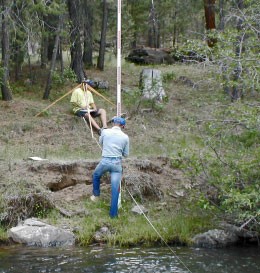Carbon Storage Atlas
Lake County Terrestrial Pilot
Lat/Long:
Lake County, Oregon (42.753127, -120.309368 Regional)
Why This Location?
Lake County, Oregon, as well as Shasta County, California, were chosen for Phase II terrestrial pilot project sites because Phase I characterization research found they offered a chance to test storage opportunities broadly available throughout the West Coast Regional Carbon Sequestration Partnership (WESTCARB) region, and also because of the willingness of partners to commit resources to the research. Previous studies had shown wildland fire to be a significant source of carbon dioxide (CO2) emissions in Lake County, and the county contains a broad spectrum of elevation, topography, forest, range, and agricultural land types, as well as land ownership types. These factors made it an excellent site for evaluating fuel management and biomass energy opportunities to reduce the risk of catastrophic fires and prevent emissions. There was also an established framework for planning and implementing forest and rangeland restoration and fuels reduction projects due to a 20-year Interagency Biomass Supply Memorandum of Understanding that was signed in Lake County by multiple public and private parties.
Main Research Q&As Discovered
The Lake County terrestrial pilot project involved assessment of forest fuel reduction treatments for emissions reduction at two sites: Bull Stewardship in the Fremont-Winema National Forest representing a public lands project, and Collins-Hot Rocks representing a private lands project. The project tasks were to compile information on site conditions, fuel treatment prescriptions, and costs, as well as to inform and field-test a wildfire greenhouse gas (GHG) emissions accounting methodology. Work included the testing of new methodologies for emissions baseline, quantifying treatment procedures versus baseline, and measurement and monitoring activities. Analysis of fuel reduction activities at both Bull Stewardship and Collins-Hot Rocks showed that the treatments resulted in overall carbon emissions, with only slight reductions in emissions in the event of a fire. The task of developing a rigorous methodology to quantify baseline emissions from wildland fires and emission reductions attributable to fuel reduction was found to be complex, due to the methodological challenges of modeling fire behavior and emissions, the relatively low annual risk of fire for any given potential project location, and the emissions resulting from fuels treatments. Given current hazardous fuel-removal technologies and the low probability of fire on any given acre in any given year, hazardous fuel reduction treatments employed in Lake County would not directly generate offsets.
Lessons Learned that Impacted Phase III Design?
The Lake County terrestrial storage pilot project did not lead to a large-scale Phase III demonstration project on forest fuel reduction as part of the U.S. Department of Energy’s (DOE) Regional Carbon Sequestration Partnership (RCSP) Program. The findings of the Lake County pilot were supported by additional work at three sites (Berry Timber, Davis, and HH Biomass) on privately owned land in Shasta County, California. The studies concluded that:
- Fuel treatments resulted in increased net carbon emissions for all projects.
- Fuel treatments are unsuitable for generating greenhouse gas (GHG) offsets on a project-by-project basis.
- Biomass-generated electricity from removed forest fuels, which avoids carbon emissions from
fossil fuels, did not compensate for the loss of carbon stored as standing timber.
However, there are other benefits of fuel-reduction treatments, including decreased severity and size of forest fires, safeguarding nearby communities from life and property loss, reduced firefighting costs, and increased timber production.
Story of Interest
Lake County Oregon forest fuels management has been incorporated into an overall strategy that combines restoration of the region’s forests with new opportunities for rural economic development. Lake County terrestrial pilot partners negotiated a 20-year Biomass Memorandum of Agreement, a preliminary non-binding supply of goods agreement, that established a framework to plan afforestation pilot projects that are supportive of the Lakeview Biomass Project. A 10-year Stewardship Contract was also negotiated to promote long-term supply of biomass material necessary to fuel local biomass or log mills that may be built. A contract with the U.S Forest Service Pacific Northwest Region provides for a supply of material to support the Collins Companies’ new small diameter sawmill (to better handle the smaller timber from restoration projects). A second project, Iberdrola Renewables’ new 27-megawatt Lakeview biomass cogeneration plant, halted construction in October 2011 for lack of a long-term power purchase agreement.




